Logarithmic spiral
A logarithmic spiral, equiangular spiral, or growth spiral is a self-similar spiral curve that often appears in nature. The first to describe a logarithmic spiral was Albrecht Dürer (1525) who called it an "eternal line" ("ewige Linie").[1][2] More than a century later, the curve was discussed by Descartes (1638), and later extensively investigated by Jacob Bernoulli, who called it Spira mirabilis, "the marvelous spiral".
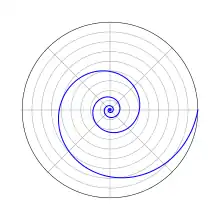
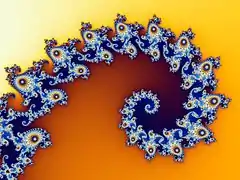
The logarithmic spiral can be distinguished from the Archimedean spiral by the fact that the distances between the turnings of a logarithmic spiral increase in geometric progression, while in an Archimedean spiral these distances are constant.
Definition
In polar coordinates the logarithmic spiral can be written as[3]
or
with being the base of natural logarithms, and , being real constants.
In Cartesian coordinates
The logarithmic spiral with the polar equation
can be represented in Cartesian coordinates by
In the complex plane :
Spira mirabilis and Jacob Bernoulli
Spira mirabilis, Latin for "miraculous spiral", is another name for the logarithmic spiral. Although this curve had already been named by other mathematicians, the specific name ("miraculous" or "marvelous" spiral) was given to this curve by Jacob Bernoulli, because he was fascinated by one of its unique mathematical properties: the size of the spiral increases but its shape is unaltered with each successive curve, a property known as self-similarity. Possibly as a result of this unique property, the spira mirabilis has evolved in nature, appearing in certain growing forms such as nautilus shells and sunflower heads. Jacob Bernoulli wanted such a spiral engraved on his headstone along with the phrase "Eadem mutata resurgo" ("Although changed, I shall arise the same."), but, by error, an Archimedean spiral was placed there instead.[4][5]
Properties
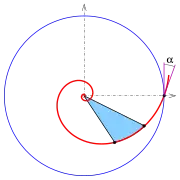
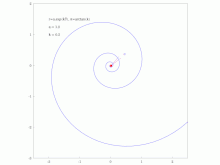
The logarithmic spiral has the following properties (see Spiral):
- Polar slope: with polar slope angle (see diagram and animation).(In case of angle would be 0 and the curve a circle with radius .)
- Curvature:
- Arc length: Especially: , if . This property was first realized by Evangelista Torricelli even before calculus had been invented.[6]
- Sector area:
- Inversion: Circle inversion () maps the logarithmic spiral onto the logarithmic spiral
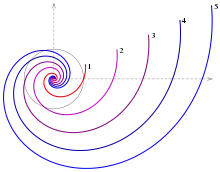
- Rotating, scaling: Rotating the spiral by angle yields the spiral , which is the original spiral uniformly scaled (at the origin) by . Scaling by gives the same curve.
- Self-similarity: A result of the previous property: A scaled logarithmic spiral is congruent (by rotation) to the original curve. Example: The diagram shows spirals with slope angle and . Hence they are all scaled copies of the red one. But they can also be generated by rotating the red one by angles resp.. All spirals have no points in common (see property on complex exponential function).
- Relation to other curves: Logarithmic spirals are congruent to their own involutes, evolutes, and the pedal curves based on their centers.
- Complex exponential function: The exponential function exactly maps all lines not parallel with the real or imaginary axis in the complex plane, to all logarithmic spirals in the complex plane with centre at : The polar slope angle of the logarithmic spiral is the angle between the line and the imaginary axis.
Special cases and approximations
The golden spiral is a logarithmic spiral that grows outward by a factor of the golden ratio for every 90 degrees of rotation (polar slope angle about 17.03239 degrees). It can be approximated by a "Fibonacci spiral", made of a sequence of quarter circles with radii proportional to Fibonacci numbers.
In nature
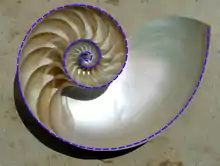
In several natural phenomena one may find curves that are close to being logarithmic spirals. Here follow some examples and reasons:
- The approach of a hawk to its prey in classical pursuit, assuming the prey travels in a straight line. Their sharpest view is at an angle to their direction of flight; this angle is the same as the spiral's pitch.[7]
- The approach of an insect to a light source. They are used to having the light source at a constant angle to their flight path. Usually the Sun (or Moon for nocturnal species) is the only light source and flying that way will result in a practically straight line.[8]
- The arms of spiral galaxies.[9] The Milky Way galaxy has several spiral arms, each of which is roughly a logarithmic spiral with pitch of about 12 degrees.[10] However, although spiral galaxies have often been modeled as logarithmic spirals, Archimedean spirals, or hyperbolic spirals, their pitch angles vary with distance from the galactic center, unlike logarithmic spirals (for which this angle does not vary), and also at variance with the other mathematical spirals used to model them.[11]
- The nerves of the cornea (this is, corneal nerves of the subepithelial layer terminate near superficial epithelial layer of the cornea in a logarithmic spiral pattern).[12]
- The bands of tropical cyclones, such as hurricanes.[13]
- Many biological structures including the shells of mollusks.[14] In these cases, the reason may be construction from expanding similar shapes, as is the case for polygonal figures.
- Logarithmic spiral beaches can form as the result of wave refraction and diffraction by the coast. Half Moon Bay (California) is an example of such a type of beach.[15]
In engineering applications
- Logarithmic spiral antennas are frequency-independent antennas, that is, antennas whose radiation pattern, impedance and polarization remain largely unmodified over a wide bandwidth.[17]
- When manufacturing mechanisms by subtractive fabrication machines (such as laser cutters), there can be a loss of precision when the mechanism is fabricated on a different machine due to the difference of material removed (that is, the kerf) by each machine in the cutting process. To adjust for this variation of kerf, the self-similar property of the logarithmic spiral has been used to design a kerf cancelling mechanism for laser cutters.[18]
- Logarithmic spiral bevel gears are a type of spiral bevel gear whose gear tooth centerline is a logarithmic spiral. A logarithmic spiral has the advantage of providing equal angles between the tooth centerline and the radial lines, which gives the meshing transmission more stability.[19]
See also
- Archimedean spiral
- Epispiral
- List of spirals
- Mice problem, a geometric problem asking for the path followed by mice chasing one another whose solution is a logarithmic spiral
- Tait–Kneser theorem
References
- Albrecht Dürer (1525). Underweysung der Messung, mit dem Zirckel und Richtscheyt, in Linien, Ebenen unnd gantzen corporen.
- Hammer, Øyvind (2016). "Dürer's dirty secret". The Perfect Shape: Spiral Stories. Springer International Publishing. pp. 173–175. doi:10.1007/978-3-319-47373-4_41.
- Priya Hemenway (2005). Divine Proportion: Φ Phi in Art, Nature, and Science. Sterling Publishing Co. ISBN 978-1-4027-3522-6.
- Livio, Mario (2002). The Golden Ratio: The Story of Phi, The World's Most Astonishing Number. New York: Broadway Books. ISBN 978-0-7679-0815-3.
- Yates, R. C.: A Handbook on Curves and Their Properties, J. W. Edwards (1952), "Evolutes". p. 206.
- Carl Benjamin Boyer (1949). The history of the calculus and its conceptual development. Courier Dover Publications. p. 133. ISBN 978-0-486-60509-8.
- Chin, Gilbert J. (8 December 2000), "Organismal Biology: Flying Along a Logarithmic Spiral", Science, 290 (5498): 1857, doi:10.1126/science.290.5498.1857c, S2CID 180484583
- John Himmelman (2002). Discovering Moths: Nighttime Jewels in Your Own Backyard. Down East Enterprise Inc. p. 63. ISBN 978-0-89272-528-1.
- G. Bertin and C. C. Lin (1996). Spiral structure in galaxies: a density wave theory. MIT Press. p. 78. ISBN 978-0-262-02396-2.
- David J. Darling (2004). The universal book of mathematics: from Abracadabra to Zeno's paradoxes. John Wiley and Sons. p. 188. ISBN 978-0-471-27047-8.
- Savchenko, S. S.; Reshetnikov, V. P. (September 2013). "Pitch angle variations in spiral galaxies". Monthly Notices of the Royal Astronomical Society. 436 (2): 1074–1083. arXiv:1309.4308. doi:10.1093/mnras/stt1627.
- C. Q. Yu CQ and M. I. Rosenblatt, "Transgenic corneal neurofluorescence in mice: a new model for in vivo investigation of nerve structure and regeneration," Invest Ophthalmol Vis Sci. 2007 Apr;48(4):1535-42.
- Andrew Gray (1901). Treatise on physics, Volume 1. Churchill. pp. 356–357.
- Michael Cortie (1992). "The form, function, and synthesis of the molluscan shell". In István Hargittai and Clifford A. Pickover (ed.). Spiral symmetry. World Scientific. p. 370. ISBN 978-981-02-0615-4.
- Allan Thomas Williams and Anton Micallef (2009). Beach management: principles and practice. Earthscan. p. 14. ISBN 978-1-84407-435-8.
- "kerf-canceling mechanisms". hpi.de. Retrieved 2020-12-26.
- Mayes, P.E. (1992). "Frequency-independent antennas and broad-band derivatives thereof". Proceedings of the IEEE. 80 (1): 103–112. Bibcode:1992IEEEP..80..103M. doi:10.1109/5.119570.
- Roumen, Thijs; Apel, Ingo; Shigeyama, Jotaro; Muhammad, Abdullah; Baudisch, Patrick (2020-10-20). "Kerf-canceling mechanisms: Making laser-cut mechanisms operate across different laser cutters". Proceedings of the 33rd Annual ACM Symposium on User Interface Software and Technology. Virtual Event USA: ACM. pp. 293–303. doi:10.1145/3379337.3415895. ISBN 978-1-4503-7514-6. S2CID 222805227.
- Jiang, Jianfeng; Luo, Qingsheng; Wang, Liting; Qiao, Lijun; Li, Minghao (2020). "Review on logarithmic spiral bevel gear". Journal of the Brazilian Society of Mechanical Sciences and Engineering. 42 (8): 400. doi:10.1007/s40430-020-02488-y. ISSN 1678-5878.
- Weisstein, Eric W. "Logarithmic Spiral". MathWorld.
- Jim Wilson, Equiangular Spiral (or Logarithmic Spiral) and Its Related Curves, University of Georgia (1999)
- Alexander Bogomolny, Spira Mirabilis - Wonderful Spiral, at cut-the-knot
External links
- Spira mirabilis history and math
- NASA Astronomy Picture of the Day: Hurricane Isabel vs. the Whirlpool Galaxy (25 September 2003)
- NASA Astronomy Picture of the Day: Typhoon Rammasun vs. the Pinwheel Galaxy (17 May 2008)
- SpiralZoom.com, an educational website about the science of pattern formation, spirals in nature, and spirals in the mythic imagination.
- Online exploration using JSXGraph (JavaScript)
- YouTube lecture on Zeno's mice problem and logarithmic spirals
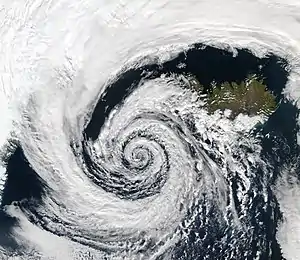

.gif)
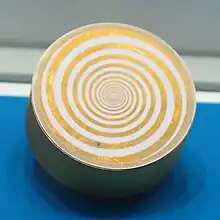
.jpg.webp)
